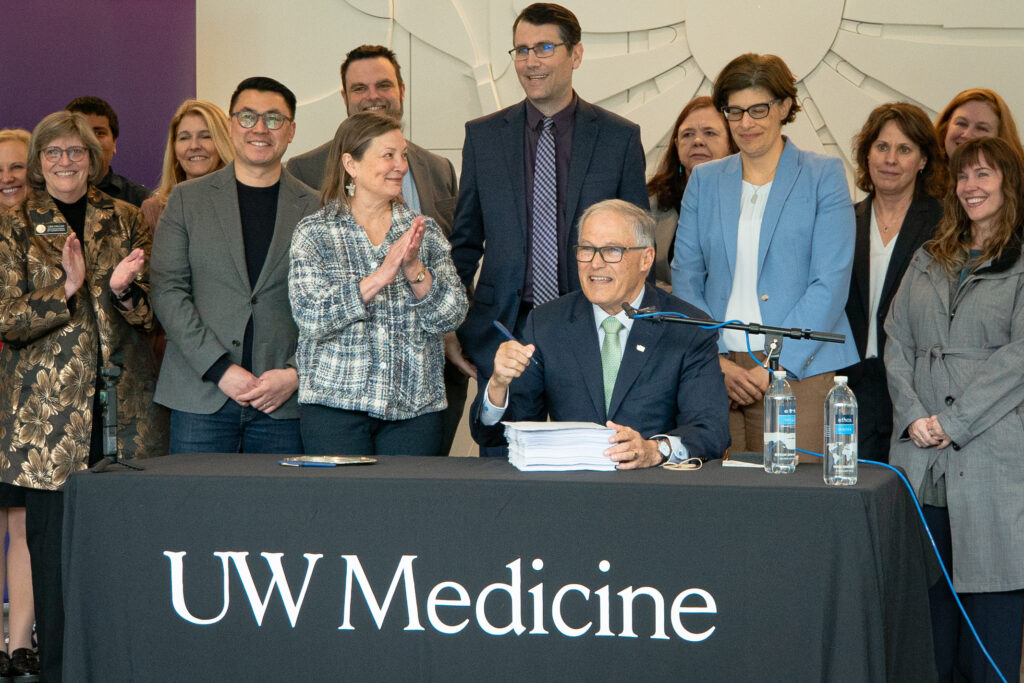
Washington Gov. Jay Inslee (seated) prepares to sign the 2024 supplemental budget on March 29, 2024. He was joined by several Democratic state lawmakers, including, to his right, Sen. June Robinson, the lead Senate budget writer. (Courtesy of UW Medicine | Nicholas Swatz)
A state revenue forecast released Wednesday shows a drop in tax collections, sobering news for Washington state lawmakers and Gov. Jay Inslee, who were already weighing options for spending cuts and raising new revenue to erase a projected $12 billion budget shortfall.
The report presented to the bipartisan Economic and Revenue Forecast Council projects tax collections will be $66.4 billion for the two-year budget that runs through June 30, 2025, a decrease of $89 million from what chief economist David Reich predicted in September.
Looking ahead, Reich estimated the state will take in $310 million less in the next two bienniums which is when Inslee has warned the multi-billion dollar deficit must be dealt with.
Wednesday’s forecast is one of the last pieces of information the outgoing governor will use to write a proposed 2025-27 budget that he will release in mid-December. That spending plan will serve as a template for lawmakers and Gov.-elect Bob Ferguson when they write budgets in the 2025 session.
Pat Sullivan, Inslee’s budget director, said Wednesday the decreased revenue projection makes the work more challenging and could lead to Inslee issuing two spending plans.
State law requires the governor to propose a budget that is balanced without any new revenue. To do that could require suggesting deep cuts in programs and services. Inslee could then put out a second budget that assumes additional revenue in order to limit reductions, a step Sullivan said is under consideration.
Meanwhile, Democratic budget writers on the forecast council said Wednesday they want to first see cost-saving ideas identified by Inslee and leaders of state agencies. They left no doubt they will be looking for additional streams of money.
“I am sure we’ll be looking at revenue options as well because $10 billion is quite a sizable gap to fill,” said Sen. June Robinson, D-Everett, chair of the Senate Ways and Means Committee.
Republicans will be resistant.
Rep. Ed Orcutt, R-Kalama, one of his caucus’s leading voices on budget and tax policies, said he’s seen Washington’s budget grow from $25 billion to $72 billion in the last two decades.
“How do I go out to my constituents and say with that kind of increase in spending I don’t have enough money,” he said. “How do I go tell them they need to give more money out of their pocket to prop up a state budget that has grown as rapidly as this one has.”
How we got here
Washington uses a biennial budget cycle, with new budgets beginning on July 1 of each odd-numbered year. The governor proposes a budget in December, and the legislature can modify it during any legislative session.
Also, Washington state law requires budgets be balanced over a four-year period.
The current two-year operating budget is about $72 billion.
The first sign of trouble came in the June revenue forecast, where collections came in nearly $500 million less than projections lawmakers and Inslee relied on to pay for new spending in the second year of the current budget cycle. The big drop was due to less consumer spending and lower-than-expected capital gains tax receipts.
September’s forecast didn’t bring much change in the financial picture. With Wednesday’s report, there’s now roughly $615 million less in revenue than they assumed earlier this year. Reserves may be needed to backfill commitments in this budget, lawmakers have said.
On Nov. 8, Sullivan warned state agencies of an anticipated operating budget shortfall between $10 billion and $12 billion over the next four years, and directed them to find ways to pare spending now. Several responded by adopting hiring freezes and curbs on travel and large purchases.
On Wednesday, he said the red ink is the result of a “perfect storm” of rising costs, increasing demand for public services and lower-than-expected tax collections.
The deficit figure represents the difference between the anticipated costs of current and promised services and programs and the projected amount of revenue that will come in to pay for them. Put another way, state agencies need $10 billion to $12 billion in additional funding to maintain current programs and services.
The outlook could’ve been even worse if things had gone differently in this month’s election.
Voters rejected initiatives to eliminate the capital gains tax, which provides hundreds of millions of dollars for early learning programs, and to erase the cap-and-trade program that’s generated more than $2 billion to fight climate change.
Nonetheless, the potential budget gap is likely much larger because the estimate does not include the amount needed to pay for all the two-year collective bargaining agreements negotiated with state employee unions. The collective price tag is $1.4 billion in the next budget and $2.85 billion over four years, according to the governor’s budget office.
Sullivan will soon decide if the deals are “financially feasible.” If the answer is yes, Inslee must pencil funding into his proposed budget to pay for them. If not, and it’s rare for a governor to reach that conclusion, tens of thousands of state workers would see no raises in the next two years.
Former Gov. Chris Gregoire in 2008 determined it was not feasible to fund contracts. She cited the far-ranging impacts of recession on the state’s economy as the reason.

